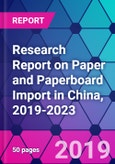According to this analysis, with the development of China's economy and the improvement of living standards, the per capita consumption of paper and paperboard shows an upward trend. Meanwhile, China's net annual population growth is between 8 million and 10 million, which leads to an increasing demand for paper and paperboard in China and promotes the development of China's papermaking industry.The Demand for Paper and Paperboard Imports in China will Continue to Grow from 2019 to 2023
However, the papermaking industry is dependent on forest resources which are scarce in China. As China tightens its environmental protection policies and the forest coverage rate decreases, the fiber materials for papermaking are in increasingly short supply. Besides, the labor costs in the Chinese manufacturing sector keeps rising. Therefore, China needs to import a large quantity of paper and paperboard to cover the shortage of domestic capacity.
The Chinese government has set no administrative barriers against paper and paperboard import, e.g. making paper and paperboard exclusive to state-owned enterprises, or introducing import quota administration for paper and paperboard. But import tariffs vary greatly among China's paper and paperboard imports. For instance, the MFN rate and general rate on the commodity that has the heaviest tax burden is respectively 35% and 100%. The import tariffs on newsprint, kraft paper, etc. are lower with the lowest MFN rate being 2%.
According to this analysis, the import volume of paper and paperboard in China is rising in recent years. It reached 6.27 million tons in 2018, increasing by 122.30% as compared to 2014. And the import value reached USD 5.53 billion, increasing by 54% as compared to 2014. The reasons for the growing paper and paperboard imports mainly include: (1) The price of imported paper and paperboard is lower than that of domestic counterparts; and (2) the quality of imported paper and paperboard is better than that of domestic counterparts. But market trends vary greatly among China's paper and paperboard imports. Overall, product segments that have great price differences with domestic counterpart see faster growth. For example, with the development of Intermedia, the sales volume of newspaper, magazines and other print media is decreasing in China, which brings down the demand for newsprint. However, the import volume of newsprint in China grew by 860% from 2014 to 2018 because the price of imported newsprint was far lower than that of domestic newsprint. In recent years, the demand for liner board keeps rising with the rapid development of the e-commerce and logistics industries. As the import price differed little from the domestic market price, the import volume of liner board in China grew by only 65.10% from 2013 to 2017.
The researcher expects that the demand for paper and paperboard imports in China will continue to grow from 2019 to 2023. The major driving forces include the lower average price of imports than domestic counterparts and the sluggish growth in domestic production of paper and paperboard resulting from the shortage of raw materials and the upward costs of labor, land, energy resources and other production factors.
Topics Covered:
- Economic and policy environment of paper and paperboard import in China
- Paper and paperboard import in China
- Major sources of China's paper and paperboard imports
- Analysis of average import price of paper and paperboard in China
- Major driving forces for paper and paperboard import in China from 2019 to 2023
- Forecast on paper and paperboard import in China from 2019 to 2023
Table of Contents
Methodology
Background research defines the range of products and industries, which proposes the key points of the research. Proper classification will help clients understand the industry and products in the report.
Secondhand material research is a necessary way to push the project into fast progress. The analyst always chooses the data source carefully. Most secondhand data they quote is sourced from an authority in a specific industry or public data source from governments, industrial associations, etc. For some new or niche fields, they also "double-check" data sources and logics before they show them to clients.
Primary research is the key to solve questions, which largely influence the research outputs. The analyst may use methods like mathematics, logical reasoning, scenario thinking, to confirm key data and make the data credible.
The data model is an important analysis method. Calculating through data models with different factors weights can guarantee the outputs objective.
The analyst optimizes the following methods and steps in executing research projects and also forms many special information gathering and processing methods.
1. Analyze the life cycle of the industry to understand the development phase and space.
2. Grasp the key indexes evaluating the market to position clients in the market and formulate development plans
3. Economic, political, social and cultural factors
4. Competitors like a mirror that reflects the overall market and also market differences.
5. Inside and outside the industry, upstream and downstream of the industry chain, show inner competitions
6. Proper estimation of the future is good guidance for strategic planning.

LOADING...








